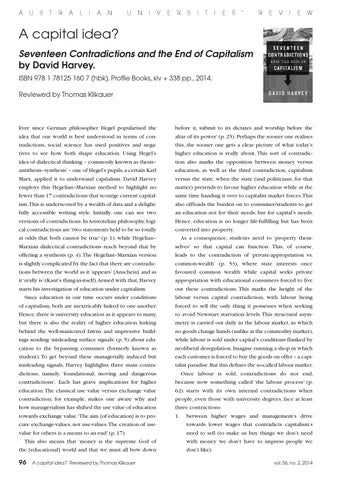A
U S T
R
A
L
I
A
N
U N
I
V
E R
S I
T
I
E
S
’
R
E V
I
E
W
A capital idea? Seventeen Contradictions and the End of Capitalism by David Harvey. ISBN 978 1 78125 160 7 (hbk), Profile Books, xiv + 338 pp., 2014. Reviewed by Thomas Klikauer
Ever since German philosopher Hegel popularised the
before it, submit to its dictates and worship before the
idea that our world is best understood in terms of con-
altar of its power’ (p. 25). Perhaps the sooner one realises
tradictions, social science has used positives and nega-
this, the sooner one gets a clear picture of what today’s
tives to see how both shape education. Using Hegel’s
higher education is really about. This sort of contradic-
idea of dialectical thinking – commonly known as thesis–
tion also marks the opposition between money versus
antithesis–synthesis’ – one of Hegel’s pupils, a certain Karl
education, as well as the third contradiction, capitalism
Marx, applied it to understand capitalism. David Harvey
versus the state, when the state (and politicians, for that
employs this Hegelian–Marxian method to highlight no
matter) pretends to favour higher education while at the
fewer than 17 contradictions that scourge current capital-
same time handing it over to capitalist market forces.This
ism.This is underscored by a wealth of data and a delight-
also offloads the burden on to consumer/students to get
fully accessible writing style. Initially, one can see two
an education not for their needs, but for capital’s needs.
versions of contradictions. In Aristotelian philosophy, logi-
Hence, education is no longer life-fulfilling but has been
cal contradictions are ‘two statements held to be so totally
converted into property.
at odds that both cannot be true’ (p. 1), while Hegelian–
As a consequence, students need to ‘property them-
Marxian dialectical contradictions reach beyond that by
selves’ so that capital can function. This, of course,
offering a synthesis (p. 4). The Hegelian–Marxian version
leads to the contradiction of ‘private-appropriation vs.
is slightly complicated by the fact that there are contradic-
common-wealth’ (p. 53), where state interests once
tions between the world as it ‘appears’ [Anschein] and as
favoured common wealth while capital seeks private
it ‘really is’ (Kant’s thing-in-itself). Armed with that, Harvey
appropriation with educational consumers forced to live
starts his investigation of education under capitalism.
out these contradictions. This marks the height of the
Since education in our time occurs under conditions
labour versus capital contradiction, with labour being
of capitalism, both are inextricably linked to one another.
forced to sell the only thing it possesses when seeking
Hence, there is university education as it appears to many,
to avoid Newstart starvation levels. This structural asym-
but there is also the reality of higher education lurking
metry is carried out daily in the labour market, in which
behind the well-manicured lawns and impressive build-
no goods change hands (unlike at the commodity market),
ings sending ‘misleading surface signals’ (p. 5) about edu-
while labour is sold under capital’s conditions flanked by
cation to the bypassing consumer (formerly known as
neoliberal deregulation. Imagine running a shop in which
student). To get beyond these managerially induced but
each customer is forced to buy the goods on offer – a capi-
misleading signals, Harvey highlights three main contra-
talist paradise. But this defines the so-called labour market.
dictions, namely, ‘foundational, moving and dangerous
Once labour is sold, contradictions do not end,
contradictions’. Each has grave implications for higher
because now something called ‘the labour process’ (p.
education. The classical use value versus exchange value
62) starts with its own internal contradictions when
contradiction, for example, makes one aware why and
people, even those with university degrees, face at least
how managerialism has shifted the use value of education
three contractions:
towards exchange value.‘The aim [of education] is to pro-
1. between higher wages and management’s drive
cure exchange-values, not use-values. The creation of use-
towards lower wages that contradicts capitalism’s
value for others is a means to an end’ (p. 17).
need to sell (to make us buy things we don’t need
This also means that ‘money is the supreme God of the [educational] world and that we must all bow down
96
A capital idea? Reviewed by Thomas Klikauer
with money we don’t have to impress people we don’t like) vol. 56, no. 2, 2014
